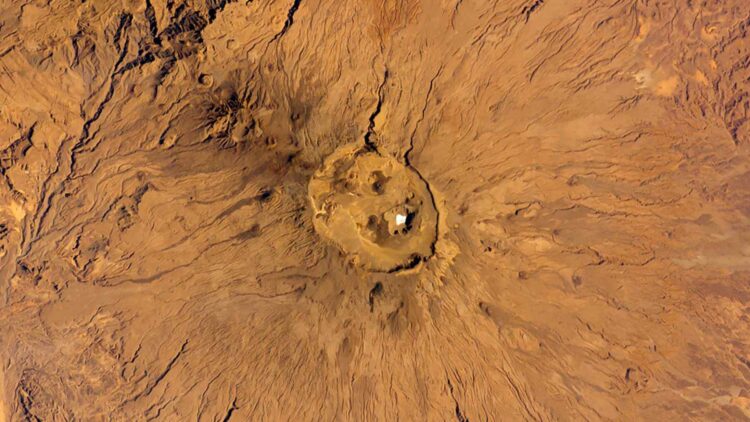The wonders of the Earth are almost endless and some of them cannot be accessed or be seen from the ground, they need a different perspective to be fully appreciated. One of these wonders is located in the Emi Koussi caldera, in Chad and it has been NASA that has shown us this marvel thanks to one of its passes from sky. The wonder that we have seen looks like a skull, and although it could be a naturally occurring skull, it is a quirk in the landscape known as Trou au Natron.
The orography of the Earth has changed a lot in the millennia that it has been forming, and although some changes can be seen today, what we can mostly see is the vestiges and remnants of prior events. This a place in Chad that was once an active glacial lake full of life, but it is now a barren piece of land where nothing grows. 14,000 years ago, the lake began to very slowly disappear and it left behind a dry, salty lakebed that glistens in the sun in the middle of the Sahara that looks from the sky like a glowing skull when the sun shines right on it.
Many have mistaken the salty lakebed as snow, and as unlikely as that would have been in the Sahara desert, it would have also been a different type of scientific discovery, but no, it is salt and its explanation, although fascinating, is mildly less scientifically relevant.
The salt skull buried in the Sahara Desert
Of course it is an optical illusion caused by the way shadows cast by the edges of the caldera appear from the sky, but that does not make the visual effect any less impressive, especially when seen by astronauts from the sky. The “eyes” are formed by natural depressions that were a long time ago, volcanos that erupted. These are now inactive and just another remnant of the past of the region, like the salt that covers them.
Emi Koussi is the highest peak in the Sahara desert and it stands at 3,415 meters high, which is quite impressive and not just for the region. Its interior caldera called Trou au Natron, reaches almost 745 meters deep and measures dozens of kilometers in diameter. It is quite hard to imagine that at one time this place was filled with fresh water and ice, forming a glacial lake that supported life forms and influenced the local climate, but then again during the Ice Age the earth was quite different than it is today and the impossible was quite different.
But the markings of that time can still be seen in the desert landscapes, especially since this area is so inhospitable and has not been traversed much, the erosion channels are carved by water, depressions formed by runoff and the saline sediments tell a story of slow and constant transformation that can be quite easily read and tell a tale of millennia of change in the region.
This discovery changes the way we see the Sahara desert, as it has been perceived for years as a place that was always dry and desolate, but what we see now is a geological marvel, which, going beyond technical terms, consists of all the layers of time, climate, and volcanic activity accumulated in natural formations and that gave origin to the fantastic skull that we can now appreciate from the sky.
It can also leave us to wonder, since the are was once a place with much more humidity and vegetation, could it become that once again decades or centuries after we have stopped existing? And, could we help it along?

